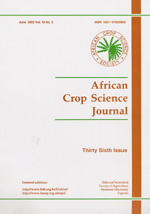
|
African Crop Science Journal
African Crop Science Society
ISSN: 1021-9730
EISSN: 1021-9730
Vol. 6, No. 3, 1998, pp. 273-282
|
 Bioline Code: cs98029
Bioline Code: cs98029
Full paper language: English
Document type: Research Article
Document available free of charge
|
|
|
African Crop Science Journal, Vol. 6, No. 3, 1998, pp. 273-282
| fr |
Wortmann, C.S.; Silver-Rwakaikara, M. & Lynch, J.
Résumé
La nutrition inadéquate d'azote est une contrainte majeure
pour la performance du haricot commun (Phaseolus vulgaris L.) en
Afrique sub-saharienne. Vingt six lignées
sélectionnées pour leur bonne performance sous les conditions
limitantes d'azote ont évaluées dans deux localités en
Uganda afin de déterminer les mechanismes liés à cette
performance sous les conditions limitantes d'azote. Deux lignées non
nodulantes ayant un rendement moyen de plus de 44 % avec l'application
d'azote ont été inclues. Les lignées testées
ont montré peu de réponse à l'application d'azote
impliquant que toutes les lignées ont fixé des
uantités importantes d'azote. L'azote obtenu de l'atmosphère
a été estimé à une moyenne de 15 à 43%
d'azote du plant dans deux localités en utilisant la technique de
l'abondance naturelle de 15N. Le rendement moyen des
lignées testées se rangeait de 810 à 1450 kg/ha
à travers deux localités charactérisées par les
conditions limitant d'azote. Les charactéristiques contribuant
à la bonne performance sous les conditions limitantes d'azote
variait pour les génotypes qui étaient regroupés en
trois groupes avec 4 génotypes basés sur l'acquisition
d'azote et sur les characteristiques d'utilisation. L'efficacité
d'utilisation d'azote pendant la croissance végétative n'a
pas été importante pour le rendement sous les conditions
limitantes d'azote. L'acquisition accrue d'azote pendant le remplissage des
gousses a été importante par rapport au rendement de quelques
génotypes, et a compensé le déficit de la biomasse et
de l'azote de la plante au commencement du remplissage des gousses. Le
rendement a été positivement lié à la biomasse
et l'azote de la plante à la maturité physiologique (R9),
mais pas à l'efficience d'utilisation d'azote dans la production de
la biomasse au stade de la maturité physiologique. La repartition
effective d'azote des parties végétatives à la graine
était importante pour la croissance sous les conditions limitantes
d'azote comme a été l'efficience d'utilisation dans la
formation des graines.
Mots Clés
BILFA, faible tolérance à l'azote, conditions limitantes d'azote, Phaseolus vulgaris
|
| |
| en |
Efficiency of nitrogen acquisition and utilisation in common bean in Uganda
Wortmann, C.S.; Silver-Rwakaikara, M. & Lynch, J.
Abstract
Inadequate nitrogen nutrition is a major constraint to the
performance of common bean (Phaseolus vulgaris L.) in sub-Saharan
Africa. Twenty six lines selected for good performance under N-limiting
conditions were further evaluated at two locations in Uganda to determine
the mechanisms allowing good performance under soil N-limiting conditions.
Two non-nodulating lines were included whose mean yield was 44% more with N
application. The test lines showed little response to applied N implying
that all fixed significant amounts of N2; N derived from the
atmosphere was estimated to average 15 and 43% of plant N for two locations
using the natural abundance 15N technique. Mean yield of test
lines ranged from 810 to 1450 kg ha-1 across two locations with
N-limiting conditions. Characteristics contributing to good performance
under N-limiting conditions varied with genotypes which were grouped into
two clusters, with four out-lying genotypes, based on N acquisition and
utilisation characteristics. Nitrogen utilisation efficiency in vegetative
growth was not important to yield under N-limiting conditions. Increased N
acquisition during podfill was important to the yield of some genotypes,
and presumably compensated for less biomass and plant N at the beginning of
podfill. Yield was positively related to biomass and plant N at
physiological maturity (R9), but not to N utilisation efficiency in biomass
production at R9. Efficient partitioning of N from the vegetative parts to
the grain was important to growth under N-limiting conditions, as was N
utilisation efficiency in grain formation.
Keywords
BILFA, low N tolerance, N-limiting conditions, Phaseolus vulgaris
|
| |
© Copyright 1998 - African Crop Science Society
|
|
